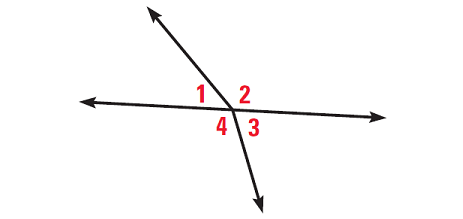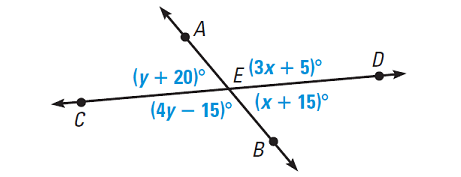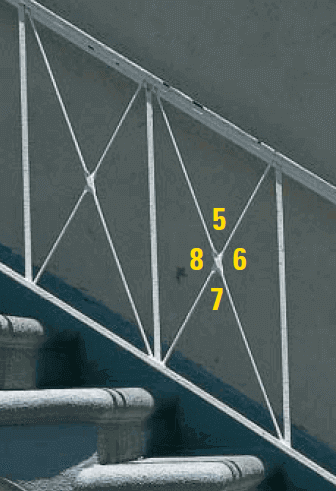VERTICAL ANGLES AND LINEAR PAIRS WORKSHEET
Subscribe to our ▶️ YouTube channel 🔴 for the latest videos, updates, and tips.
Problem 1 :
Look at the picture shown below and answer the following questions.
(i) Are ∠2 and ∠3 a linear pair ?
(ii) Are ∠3 and ∠4 a linear pair ?
(iii) Are ∠1 and ∠3 vertical angles ?
(iv) Are ∠2 and ∠4 vertical angles ?

Problem 2 :
In the diagram shown below, solve for x and y. Then, find the angle measures.

Problem 3 :
In the stair railing shown at the right, m∠6 has a measure of 130°. Find the measures of the other three angles.


1. Answer :
(i) Are ∠2 and ∠3 a linear pair ?
(ii) Are ∠3 and ∠4 a linear pair ?
(iii) Are ∠1 and ∠3 vertical angles ?
(iv) Are ∠2 and ∠4 vertical angles ?
Solution (i) :
No. The angles are adjacent but their non-common sides are not opposite rays.
Solution (ii) :
Yes. The angles are adjacent and their non-common sides are opposite rays.
Solution (iii) :
No. The sides of the angles do not form two pairs of opposite rays.
Solution (iv) :
No. The sides of the angles do not form two pairs of opposite rays.
2. Answer :
Use the fact that the sum of the measures of angles that form a linear pair is 180°.
Solving for x :
∠AED and ∠DEB are a linear pair.
m∠AED + m∠DEB = 180°
Substitute m∠AED = (3x + 5)° and m∠DEB = (x + 15)°.
(3x + 5)° + (x + 15)° = 180°
Simplify.
4x + 20 = 180
Subtract 20 from each side.
4x = 160
Divide each side by 4.
x = 40
Solving for y :
∠AEC and ∠CEB form a linear pair.
m∠AEC + m∠CEB = 180°
Substitute m∠AEC = (y + 20)° and m∠CEB = (4y - 15)°.
(y+20)° + (4y-15)° = 180°
Simplify.
5y + 5 = 180
Subtract 5 from each side.
5y = 175
Divide each side by 5.
y = 35
Use substitution to find the angle measures :
m∠AED = (3x + 5)° = (3 • 40 + 5)° = 125°
m∠DEB = (x + 15)° = (40 + 15)° = 55°
m∠AEC = ( y + 20)° = (35 + 20)° = 55°
m∠CEB = (4y º 15)° = (4 • 35 - 15)° = 125°
So, the angle measures are 125°, 55°, 55°, and 125°. Because the vertical angles are congruent, the result is reasonable.
3. Answer :
∠5 and ∠6 form a linear pair.
m∠5 + m∠6 = 180°
Substitute m∠6 = 130°
m∠5 + 130° = 180°
Subtract 130° from both sides.
m∠5 = 50°
∠6 and ∠7 also form a linear pair. So, it follows that
m∠7 = 50°
∠6 and ∠8 are vertical angles. So, they are congruent and they have same measure.
m∠8 = m∠6 = 130°
Therefore,
m∠5 = 50°
m∠7 = 50°
m∠8 = 130°
Subscribe to our ▶️ YouTube channel 🔴 for the latest videos, updates, and tips.
Kindly mail your feedback to v4formath@gmail.com
We always appreciate your feedback.
About Us | Contact Us | Privacy Policy
©All rights reserved. onlinemath4all.com

Recent Articles
-
US Common Core K-12 Curricum Algebra Solving Simple Equations
Jan 06, 26 04:54 AM
US Common Core K-12 Curricum Algebra Solving Simple Equations -
10 Hard SAT Math Questions (Part - 4)
Jan 05, 26 06:56 PM
10 Hard SAT Math Questions (Part - 4) -
10 Hard SAT Math Questions (Part - 3)
Jan 05, 26 06:34 PM
10 Hard SAT Math Questions (Part - 3)

